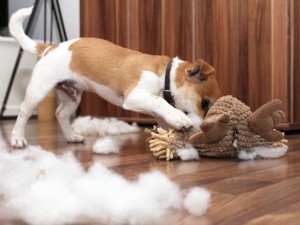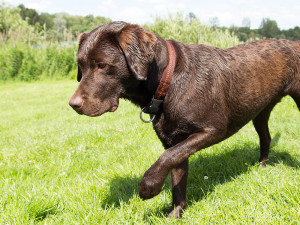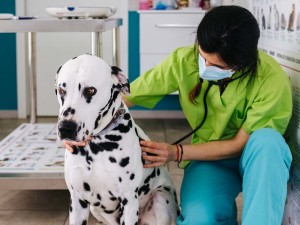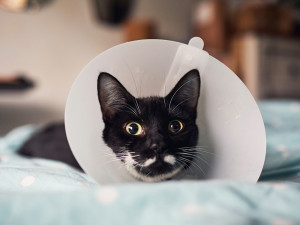Um, What Did Your Dog Just Eat?
A vet’s-eye-view of an all-too-common problem.

share article

Your pet wants you to read our newsletter. (Then give them a treat.)
Ever wonder what it costs for a vet to remove something from your dog’s GI tract? If you haven’t already found out in the worst way possible, know that vets call the procedure the “$1,000 sockopens in a new tab.” That should put things into perspective for you. Here’s how to prevent your dog from eating something bad, which can be not only very costly but also dangerous for your beloved pet.
When Dogs Eat Something They Shouldn’t
Dr. Matthew McCarthy, the owner of Juniper Valley Animal Hospital in Middle Village, Queens, N.Y., has removed many bad things dogs have ingested — called gastrointestinal foreign bodies. Vets call them GIFBs to refer to any object in an animal’s stomach, intestines, or colon. Dogs are definitely the worst offenders; cats are much more selective/picky.
“For us vets, GIFBs are quite an exciting topic, kind of like party favors, as you never know what you will find,” Dr. McCarthy says. “Put a couple of vets together and bring up the topic of GIFBs, and the conversation will resemble the scene from the movie Jaws, where Quint, Brody, and Hooper are trying to one-up each other on their various scars. Except for us, it’s the size, the amount, and the strangeness of the object retrieved.”
Things Ingested by Dogs
The reality is, dogs will eat pretty much anything. But they definitely have a weakness for items that are food-related, such as pork, beef, or chicken bonesopens in a new tab. They will even swallow things that just smell like food: kitchen rags, sink sponges, and metallic food containers, for example.
Sweetly, or creepily, dogs will chewopens in a new tab and even eat things that have their person’s scent on them, such as underwear, tampons, diapers, and anything in a laundry basket. Don’t think they limit it to scented items — coins and rocks are everyday items swallowed by dogs, and sometimes, these items can even get stuck in a dog’s throat.
“Lately, Apple AirPods seem quite delicious, but vets have retrieved remote controls, infant pacifiers, Lego pieces of all sorts (actually, small kids’ toys in general), lipstick cases, and batteries. Quite a few dogs seem proficient at removing the squeakers from plush toys and making a snack of them,” says Dr. McCarthy.
Common Signs That Indicate a Dog Ate Something Bad
If your dog is showing any of these common blockage symptoms, that’s a bad sign.
Loss of appetite
An inability to poop
Vomiting
Diarrhea
Restlessness
Abdominal pain
Whining
Lethargy
They might also seem to be depressed, restless, weak, or showing signs of dehydration or abdominal pain, even crying and whining. Pay attention to abnormal behaviors, especially if they’re not resolving quickly.
Why Dogs Eat Things They Shouldn’t
Some things are obviously food-related, but for other objects, it’s anyone’s guess. “It’s reasonable to assume that boredopens in a new tab or anxiousopens in a new tab dogs may be more prone to destructive behaviors that may result in the inadvertent ingestion of indigestible items,” says Dr. McCarthy.
“Some metabolic conditions, such as anemia or certain vitamin deficiencies, may cause both dogs and cats to want to ingest nonfood items. However, in those instances, they seem to go after more organic substances, such as dirt, cat litter, wood, gravel, grass, or rocks,” answers Dr. McCarthy. This condition is called pica and it is quite different from the ingestion of man-made objects — also, fun fact: Humans can get pica, too. New fear unlocked.
Are Some Breeds More Likely to Get Into Trouble?
Dr. McCarthy says big goofy breeds, such as Labradors and Golden Retrievers, as well as any combination of these, such as Labradoodles and Goldendoodles, most often chomp down on non-digestibles.
When You Should Visit The Vet
The most obvious answer is if you see your dog ingest something, it’s time to go to the vet. “Depending on the item and a dog’s size and breed, if caught fairly soon, there is a good chance a vet can get them to vomit up the item,” says Dr. McCarthy. For those who go a little too late, who have perhaps swallowed an object that is too big to vomit up, or for breeds for which it’s not safe to induce vomiting, the treatment is trickier. French or English Bulldogs are particularly vulnerable to the latter, because vomitus may wash back into their lungs, causing pneumonia.
If you know what they ate and vets can devise a plan for its retrieval, the less likely it is that they will need more radical surgery and an extended stay in the hospital. “Unfortunately, most gastrointestinal, foreign-body patients show up after several days of vomiting and lack of appetite, with their pet parents unaware they have eaten anything of concern. These patients often need more complicated surgeries and have extended hospital stays,” says Dr. McCarthy.
How Much Is Treatment For Removal?
This depends on two things: what they ate and when they ate it, and the treatment required to remove the obstruction.
Vomiting
If you see the pet ingesting the object, your vet will tell you that it’s most cost-effective to induce vomiting. “Typically, treatment includes an exam, an injection to cause the vomiting, and another to stop the vomiting. This could be from around $125 to $200, depending on the pet’s size (bigger dogs need more drugs as part of this process),” answers Dr. McCarthy.
Endoscopic
“If vomiting is not an option, then endoscopic retrieval, using a flexible tube with a light, camera, and hook to grab the object and guide it back up through the esophagus and out the mouth, may be an option.” Like surgery, this procedure requires anesthesia; however, as it is a fairly rapid and non-invasive procedure, the cost is significantly less than surgery and a hospital stay — typically, in the range of several hundred dollars.
Surgery
In those cases, where the pet parents are not aware that their dog ate anything and the pet arrives with nonspecific signs of anorexia and vomiting, in addition to a physical exam, vets perform various diagnostics, including bloodwork; radiographs, and in some cases, an ultrasound of the gastrointestinal tract. These tests add to the overall cost and are more likely to require complicated or extensive surgeries and extended hospital stays.
Specialist
“At a general, non-specialty practice, a straightforward gastrointestinal foreign-body surgery without complications typically costs around $1,500 to $2,000. Complications could include the need to remove one or more sections of the intestine (called resection and anastomosis) or to deal with widespread abdominal infection (peritonitis) from a ruptured intestine,” says Dr. McCarthy. With complications, expect the cost to double or even triple. In some cases, if the foreign body has caused so much damage that surgery needs to be performed by a veterinary surgery specialist, the costs could exceed $5,000.
Preventing Your Dog From Swallowing Foreign Objects
For puppies, you really want to puppy-proofopens in a new tab your house by keeping anything the pup can get in their mouth, such as keys, remote controls, rubber bands, and hair ties, out of sight. If this isn’t possible, then confining the dog to one particular room, crate, or kennel when they’re not being directly observed, is fine. For those large goofy dog breeds, such restrictions may need to go on well beyond puppyhood.
“If your pet has shown an inclination to tear apart and eat blanketsopens in a new tab or plush toys, do not allow them to have these items. Switch them out for chew-proof beds and food puzzles. Repeat offenders, meaning they have ingested a foreign body more than once, wear light basket muzzles most of the time,” says Dr. McCarthy.
On walks with dogs
Watch your dog, not your cell phone. Dogs will happily swallow whatever they find while you’re scrolling.
Shorter leashes of four to six feet are better, because it’s difficult to see what your dog is doing 12 feet in front of you.
Carry treats to trade for non-edible objects.
Consider a light basket muzzle if your dog is a known offender.
At home with dogs
Inspect toys to make sure size and hardness are appropriate.
Be careful with soft or plush chew toys, especially if they have yummy squeakers.
Puppy-proof your house: nothing mouth-sized within reach should be left out.
For young dogs in particular, consider confinement to a safe-chew zone, such as an extra room, a large crateopens in a new tab or kennel, or a playpen for smaller breeds.
Get pet insurance. Not only can it defray the costs involved in treating/removing GIFBs, it can be lifesaving.
Obstructions and GIFBs are no joke. Contact your veterinarian immediately if you see your dog ingest something that seems concerning, or if your pet looks “off” or repeatedly vomits, especially after meals. And if you know your dog has eaten something that may be toxic, call the ASPCA Animal Poison Control Center at (888) 426-4435.
Judy Mandell
Judy Mandell has contributed to The New York Times, The Washington Post, and many other major newspapers and magazines. She lives in Virginia, just south of Charlottesville, with her handsome husband and her adorable dog Maple.
Related articles
![A woman in a bright yellow-orange sweater holding a striped kitten in one hand and a credit card in the other while using her laptop in front of her]() opens in a new tab
opens in a new tabCan’t Pay Your Pet’s Vet Bills? These Orgs Can Help
When the bills rack up, these resources have your back.
![French bulldog being examined at the vet via stethoscope]() opens in a new tab
opens in a new tab9 Tips For Saving Money At the Vet
Ways to lower your bill — without compromising your pet’s health.
![Brown Labrador lifting front leg]() opens in a new tab
opens in a new tabHow to Get a Head Start on Your Pet’s Health
Spot lumps, limps, and lethargy early on.
![Dalmatian and Great Dane mixed dog at the vet being checked on by a nurse in bright green scrubs]() opens in a new tab
opens in a new tabBeware of Bloat in Dogs
Consider it the mother of all dog emergencies — if your dog has it, take them to the vet ASAP. Learn how to spot the condition and how it's treated.
![Black cat with white spots on its fur laying on a light blue blanket while wearing a con around its head]() opens in a new tab
opens in a new tabBe Prepared: Four Pet Emergency Room Essentials for Pet Parents
Lay the groundwork for quick, low-stress treatment.
![Uncomfortable looking gray cat sitting on a window sill]() opens in a new tab
opens in a new tabShould Your Cat Go to the ER?
Here are six good reasons to haul tail to the emergency room.









